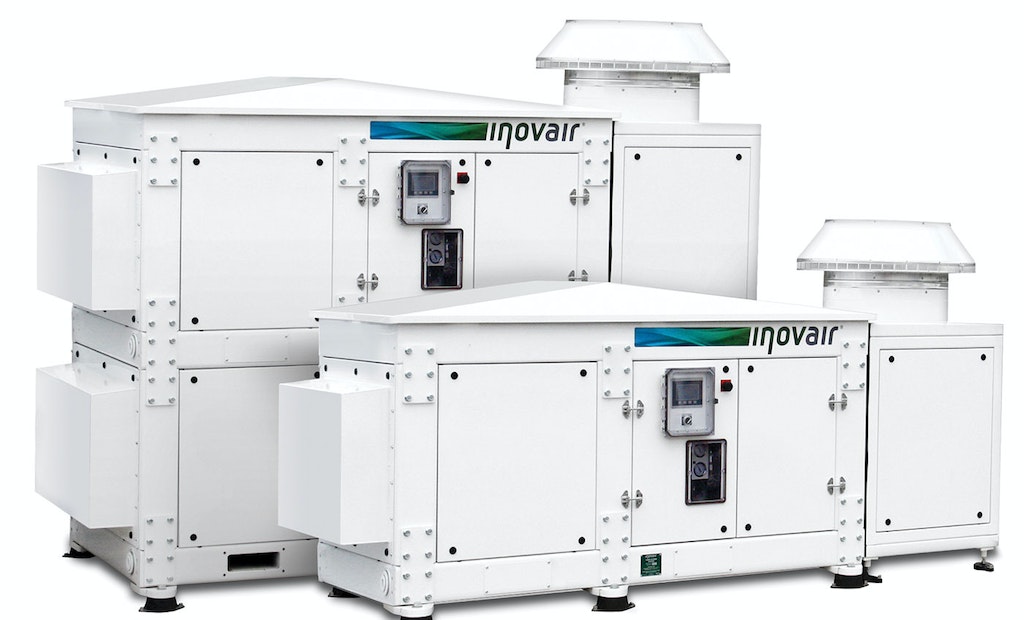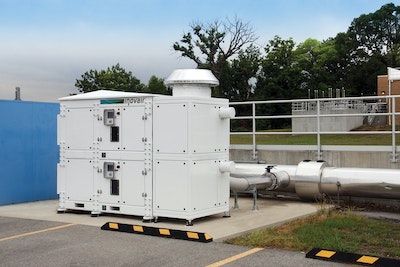
The blowers use oil-film bearings on the high-speed shaft so that the bearings never contact the shaft.
Interested in Blowers?
Get Blowers articles, news and videos right in your inbox! Sign up now.
Blowers + Get AlertsAeration for secondary treatment is typically the largest source of electric power demand in clean-water plants, accounting for roughly half the total energy usage.
Turbo blowers of different types have increased aeration energy efficiency by up to 40%, driving down electric bills significantly. In recent years, Inovair has offered a different twist on turbo blower technology to the wastewater treatment market.
The company’s IM, IE and IO Series blowers are integrally geared and use noncontact oil-film bearings. The IO Series offers the company’s lowest cost per unit volume of air and the most compact footprint. The IE provides the same benefits except in a weatherproof package, while the IM Series provides a direct-coupled modular design.
All three can fulfill a wide range of airflow demands and are designed for a broad turndown range to fit variable aeration requirements. Glen Roderique, a sales engineer, talked about the technology in an interview with Treatment Plant Operator.
TPO: Why did Inovair decide to bring this blower to the wastewater treatment market?
Roderique: Our main focus was to offer energy savings over existing technologies such as positive displacement and multistage blowers. We had our first installation in the wastewater industry in 2013.
TPO: In what applications was this technology proven before it entered the wastewater sector?
Roderique: In 2008 we built similar blower packages with different controls for the pneumatic conveying market in facilities such as flour mills. They used the same gearbox and head unit that we now use in our wastewater products. The same gearbox is used in aircraft ground support equipment for the U.S. military F-35 strike fighter. Our compressor blows air into the cockpit when the aircraft are being serviced. As part of certification for that, we performed startups at 40 degrees below zero. We have also used our compressor in industrial drying applications where we brought air into the compressor at about 325 degrees F. It has proven very durable over a wide temperature range.
TPO: How does an integrally geared design differ from the design of other turbo blowers?
Roderique: It uses a gearbox to step up the speed of a standard 1,800 or 3,600 rpm motor to the operating speed of the impeller. Other turbo blowers use a high-speed permanent magnet motor that actually runs at 25,000 to 30,000 rpm, which use airfoil or magnetic bearings.
TPO: What do you see as the benefit of the integrally geared configuration?
Roderique: We are able to use off-the-shelf components such as standard motors and standard variable-frequency drives. Mechanics at treatment plants typically understand gearboxes and these standard components.
TPO: How do oil-film bearings work, and what are their benefits?
Roderique: On the high-speed shaft, we use floating-ring oil-film bearings. The oil film creates a hydrodynamic wedge so that the bearing never contacts the shaft. It’s the same technology used in turbochargers on cars for the last 40 to 50 years. This design makes for a very stiff bearing that tolerates challenging conditions and can operate down to relatively low speeds.
TPO: What is the advantage of lower-speed operating capability?
Roderique: Generally we operate in the range of 25,000 to 45,000 rpm, even though the gearbox is designed to operate at up to 60,000 rpm in continuous duty. For applications like aerobic digesters and sequencing batch reactors, we can operate over an extremely wide range of liquid levels. We can turn down the airflow significantly at lower pressures, and that helps save energy.
TPO: Can the integrally geared blower tolerate frequent start-stop cycles?
Roderique: Yes. With the oil-film bearing, we have an oil pump mechanically attached to our input shaft. Anytime the shaft is rotating — on startup or shutdown, on ramp-up or coast-down — lubrication is being provided to the bearings. The oil is cooled, and the internal hydrodynamic wedge keeps the shaft centered in the bearings. There is no issue with stop-start conditions or with operating in a dusty environment, such as near a construction site.
TPO: What is involved in maintenance for this technology?
Roderique: We require annual oil changes after a year of continuous duty. A plant that cycles blowers on and off can go up to two years between oil changes as long as the operational hours don’t exceed 9,000. Also, we try to make the units as serviceable as possible. With every sale, we provide a small electric service pump. The units themselves have quick-disconnect fittings on the oil service lines. The oil-change procedure is simple and typically takes about 30 to 45 minutes.
TPO: How does the use of off-the-shelf components help facility operators?
Roderique: We use off-the-shelf Allen-Bradley PLCs (Rockwell Automation) and drives from ABB and others. With those industry standard components, if something happens at the plant, such as if a lightning strike disables a PLC or a VFD, the operators can simply go to their local supply house and buy a replacement. It makes for easy maintenance and service.
TPO: What size facilities can this technology accommodate?
Roderique: Traditionally, geared units were basically for plants that needed motors 500 hp and larger. What we’ve done is bring that technology down to smaller plants that haven’t been cost-effectively served by high-efficiency turbo blowers. We focus on facilities that require 400 to 2,000 cfm, which means plants treating roughly 0.5 mgd to 10 mgd.
TPO: What do your blower control packages include?
Roderique: As a vertically integrated company, we do as much manufacturing in-house as possible, and that includes designing and manufacturing of our control panels. We can be very cost-effective for smaller plants that don’t have automated dissolved-oxygen control or all they can do is start and stop a blower. We can provide a DO feedback system with a master control panel. That makes us essentially a one-stop shop.
TPO: Can you give an example of a successful installation of your blowers?
Roderique: The 10 mgd Sni-A-Bar Wastewater Treatment Plant serves the cities of Blue Springs and Grain Valley, Missouri, and is part of the greater Kansas City metro area. The plant uses a nitrification-denitrification cycle. Replacement of two of the four original rotary-lobe blowers with integrally geared turbo blowers reduced energy usage by more than 35% and improved process control. A second phase replaced the remaining old blowers and led to more than 40% energy savings. Those savings were independently verified by a third-party.






